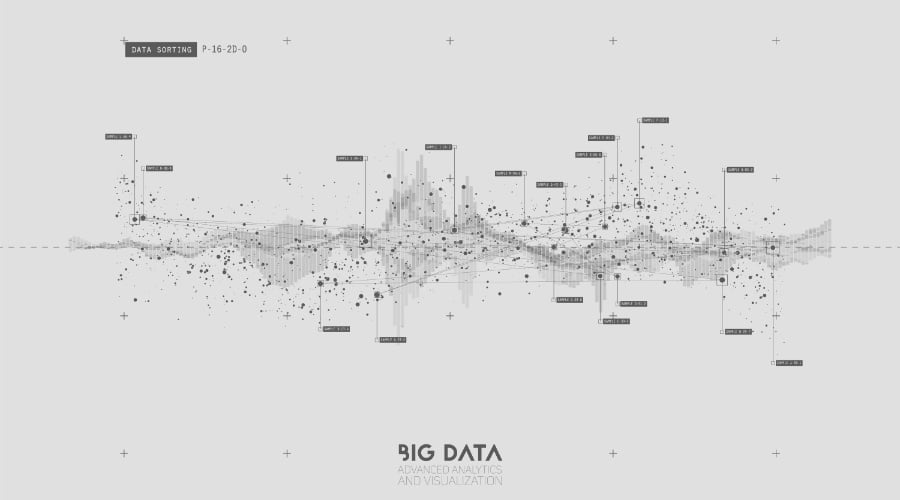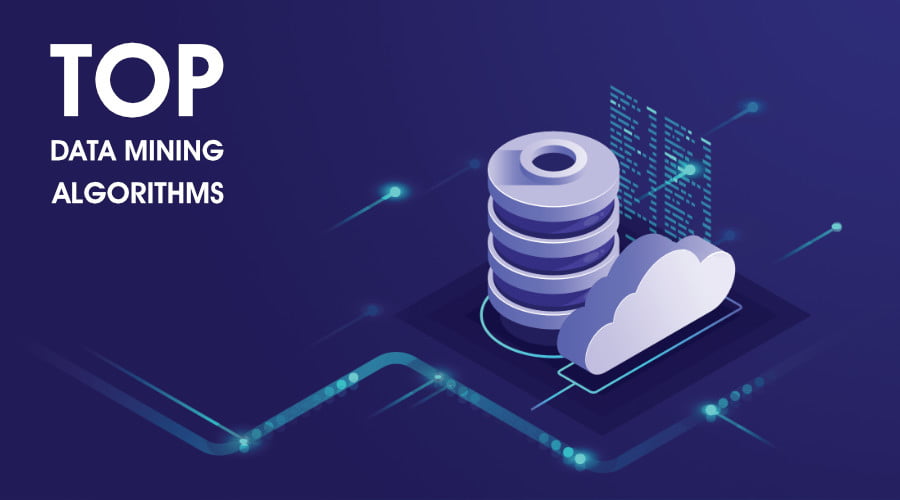
Data mining algorithms are a powerful tool for uncovering valuable insights from raw data. But what is data mining, and how does it work? This post dives into the definition of data mining, explains the different types of data mining algorithms, provides examples of some typical applications and discusses the advantages of using these powerful data tools.
Whether you are a marketer looking to extract trends from customer behaviour or an analyst trying to understand financial performance, you can use these methods to build predictive models that provide meaningful results from your data sets.
So, do you want to move beyond static reporting and use your data more creatively? Keep reading!
Introducing Data Mining Algorithms
What is Data Mining?
Data mining is a field of data science that involves using complex algorithms and Machine Learning techniques to discover insights from data. Data mining was developed in the 1970s. Data scientists use it to apply various data analysis techniques to data sets in different industries, such as financial services.
The data mining goal is to predict patterns or trends that may be difficult to detect in unstructured data sets. Over time, data mining technology has advanced and incorporated deep learning techniques into the mix. This way, you can get accurate results faster than ever before.
With advancements in data mining, your company can uncover powerful insights. To this day, data mining is an invaluable tool for exploring large data sets and provides your business with unique growth opportunities.
What is an Algorithm in Machine Learning?
Data mining (or Machine Learning) Algorithms are digital models that uncover patterns and trends in large amounts of data. With data mining algorithms, Machine Learning modelling can detect anomalies, discover relationships between variables, and predict future behaviour.
In essence, Machine Learning algorithms involve sorting through complex datasets systematically by leveraging Machine Learning techniques such as clustering and classification. To further explain, data mining algorithm types can be supervised (input variables are pre-defined) or unsupervised (input variables must be identified using statistical modelling).
Examples of Machine Learning applications include facial recognition software or self-driving cars, which rely on Machine Learning algorithms trained on numerous data sets. Therefore, one advantage of data mining algorithms is their ability to uncover knowledge from large quantities of raw data faster than manual methods and draw insights that may not be visible at first glance.
Types of Data Mining Algorithms
Data mining uses various algorithms to explore the data using pattern recognition, statistical analysis, and machine learning methods. Types of data mining algorithms can range from linear regression to artificial neural networks.
Linear regression looks at factors that may affect the outcome of a variable by fitting a line that best describes the relationship between two variables. Meanwhile, neural networks involve multiple layers of nodes, simulating neurons in the human brain to identify nonlinear relationships within datasets and classify complex patterns for accurate analytics.
Both algorithms are essential for unlocking deeper insights from data sets and have been implemented successfully in numerous industries worldwide. The four types of data mining algorithms are Regression, Classification, Association and Clustering.
Regression algorithms can predict a numeric value based on existing data. An example of this type would be Linear Regression, which finds correlations between variables, such as forecasting sales or predicting stock prices.
Classification algorithms establish to which category new data belongs by comparing it to previous examples (for instance, facial recognition technology that can differentiate between different faces).
Association algorithms enable searching for items related to an initial search query, such as suggestions during shopping on the web or online marketplaces (Amazon, eBay, Alibaba, etc.).
Clustering algorithms find similarities between pieces of data and group them for further analysis by other algorithms. An example is grouping students by age or separating them into classes according to their abilities.
Let’s see these types of data mining algorithms in detail.
Regression Algorithms
Regression algorithms are well-suited to navigate large sets of complex data with many variables. Regression data mining methods help analysts quickly and effectively find correlations between multiple performance indicators in their datasets.
Regression algorithms let you test assumptions, predict future values, and understand your data better.Moreover, they can aid in understanding non-linear relationships that would have been difficult to visualise using traditional analysis techniques such as spreadsheets or graph plotting.
By utilising these powerful algorithms, you can optimise the accuracy of your predictive models and simulate ‘what-if’ scenarios to identify the most successful courses of action.
Classification Algorithms
Classification algorithms recognise categories within a data set by assigning clearly defined labels. Therefore, you can use them to categorise documents, classify different types of medical images, identify customers for targeted marketing campaigns, detect fraud and more.
Association data mining algorithms
Association data mining algorithms are an integral tool for uncovering a range of relationships within enormous data sets. These powerful algorithms assist you in discovering dependencies between two items, such as medical symptoms and conditions or product merchandise and sales.
Associated data mining enables professionals to make predictions based on such apparent correlations. They provide comprehensive insight into how specific variables interact with each other.
Association algorithms come in handy when the goals of research initiatives involve forming linkages between complex data sets over extended periods. They help you make sense of seemingly endless amounts of disparate information, ultimately making it easier to generate informed decisions quickly and accurately.
Clustering Algorithms (segmentation and sequences)
Clustering algorithms facilitate object classification in a data set by sorting them into similar overarching groups based on their values. Clustering algorithms also provide insight into how specific attributes interact, which can help you better understand trends or factors that influence outcomes.
Clustering algorithms work by grouping items with similar qualities, allowing for a more accurate and efficient analysis of the entire data set. They can be helpful when dealing with unstructured or semi-structured data sets, such as text documents and images. You can use them for customer segmentation by dynamic behaviours and static demographics.
Sequence algorithms analyse sequences of events across your business operations to gain insights that can boost performance, productivity, and profit. For example, sequences algorithms can identify sequences in customer purchases, web clicks, and other activities, which could lead to expanded product offerings or improved marketing strategies tailored to specific consumer behaviour.
Additionally, sequences algorithms can detect sequences in production processes and aid with stock management to ensure the right products are ready just in time.

Top 15+ Data Mining Algorithms
Data mining algorithms can be of different types (deep learning, neural networks, supervised learning, clustering, decision trees, and rule-based models).
The most common data mining algorithms include Naïve Bayes classification, Support Vector Machines (SVMs), Random Forest, C5.0 Algorithm, K-Nearest Neighbors (KNN), Logistic Regression and Association Rule Learning algorithms like Apriori and Eclat.
Each data mining algorithm type has different strengths depending on the application and data you want to analyse. By understanding the pros and cons of each data mining algorithm, you can choose which is best for a particular purpose.
1) C4.5 Decision-Tree Algorithm
C4.5 is a decision-tree algorithm developed by Ross Quinlan in 1993. It’s also known as ID3 (Iterative Dichotomizer). You can use it to build classifiers utilising a set of given data, which are constructed using a hierarchical structure.
C4.5 Decision-Tree Algorithm can quickly discover and utilise the best attributes associated with a given data set. It can handle continuous values for attributes and effectively manage missing attribute values. C4.5 processes the data and assigns importance levels based on weights. Then, it ranks it before making a prediction, resulting in more accurate decisions based on prediction models generated from diverse datasets.
C4.5 works with both categorical and numerical data. It enables you to build a classifier from numerical or nominal attributes. It can easily handle noise and overlapping classes in training datasets.C4.5 is reliable, easy to use, and highly versatile compared to other data mining methods like clustering or artificial neural networks.
2) J48 Algorithm
J48 utilises the C4.5 algorithm. It’s an improvement on the earlier ID3 algorithm to generate decision trees from data sets. It works quickly and reliably, employing a reduced memory feature. J48 can handle numeric values and categorical variables with distinctly different outcomes.
3) C5.0 Algorithm
The C5.0 is a rule-based system that uses decision trees to determine relationships between input data sets through an algorithm based on the C4.5 version of Decision Tree Learning. It splits datasets into multiple branches to generate patterns.
C5.0 also can update itself from new training datasets and adapt its modelling capabilities in response to changing conditions. This data mining technique uses a series of heuristics, including pruning, cross-validation, boosting, and bagging, which allow C5.0 to create reliable models faster than other methods.
The pruning methods further enhance the algorithm’s performance. This helps reduce unnecessary branches within decision tree models and increases accuracy further.
C5.0 is suitable for wide-ranging applications that require precise predictions, including fraud detection, customer segmentation, and credit risk management.
4) ID3 Algorithm
ID3 builds a decision tree from a data set containing inputs and their respective classes. It uses entropy and information gain to create rules iteratively to classify the input data. As such, you can use ID3 in applications such as market analysis, medical diagnosis, and disease prediction.
This data mining algorithm is simple and effective, robust against incorrect values, and good at handling numerical and categorical data. Furthermore, ID3 offers multiple splitting criteria within the same model while generating an optimal decision tree with minimal complexity. This helps provide an accurate representation of the data set.
5) CART Algorithm
CART (Classification and Regression Tree) is powerful and easy to use. It splits data into different categories and allows you to optimise training and evaluate accuracy before making decisions.
CART has a non-parametric nature, fast performance speeds, and can handle numeric and categorical data.
The CART algorithm can also represent all the results visually for straightforward interpretation and sharing with stakeholders. CART’s effective use of binary recursive partitioning makes it ideal for diverse data mining tasks, including supervised machine learning classification and regression problems.
6) FP-Growth (Frequent Pattern Growth Algorithm)
FP-Growth uses an FP-tree (Frequent Pattern Tree) data structure to reduce the time and space required for mining frequent patterns from transactional databases. Via its efficient tree-based representation, FP-Growth can discover the complete set of recurring patterns without exhaustively enumerating all itemsets in the database.
FP-Growth is also suitable for association rule mining with additional processing steps. The parallelisation capability allows faster performance on large data sets. In addition, FP-Growth is used for market basket analysis and highly complements customer segmentation techniques used in retail environments.
7) PageRank Algorithm
The PageRank algorithm was developed in 1998 by the founders of Google, Sergey Brin and Larry Page, to rank web pages according to their importance. PageRank analyses link popularity between webpages, assigning more reputation to pages linked from higher-ranking websites.
Modern search engines still use PageRank today to rapidly index and rate web pages to return accurate results to users. You can also use it for Social Media Analysis. We will talk about that in detail later. Stay tuned!
8) Apriori Algorithm
The Apriori algorithm can identify frequently appearing itemsets and generate association rules. It finds hidden patterns and correlations by utilising the frequent itemset, which helps reduce computation time.
The Apriori algorithm can find partial data structures that belong together and helps recognise previously unknown associations of large data sets within different databases.
9) Support Vector Machines (SVM) Algorithm
The SVM algorithm provides accurate predictions and reduces data loss by calculating the proper hyperplane (using a Support Vector Method), which breaks down the complexities of a given dataset into manageable chunks.
Support Vector Machines can easily integrate new data points without compromising accuracy and scalability. They are highly modular and easily modified according to the unique characteristics of individual data sets to improve performance.
10) Expectation-Maximization (EM) Algorithm
The Expectation-Maximization algorithm can cluster large, high-dimensional data sets with ease. It can accurately capture previously unknown relationships between various pieces of data.
As for scalability and speed, an Expectation-Maximization algorithm can rapidly analyse vast information repositories and reduce run times significantly.
Moreover, this algorithm type can handle incomplete data sets by estimating missing values through the provided data points.
11) KNN (K-Nearest Neighbours) Algorithm
KNN is a supervised learning technique that classifies data points by comparing them to their ‘K’ closest neighbours. KNN is simple and intuitive and identifies similar objects within its data set.
KNN determines the distance between two objects by assessing their similarity. This helps you group observations belonging to one category. KNN is simple to understand and implement, requires minimal computation time, a small amount of training data, and does not assume any underlying data distribution.
You can use it for classification and regression tasks (assuming the K value is set correctly). KNN has been successfully used in trending applications like recommendation systems, market segmentation, and predictive analytics.
12) Artificial Neural Network (ANN) Algorithm
The ANN algorithm combines Artificial Intelligence (AI) and Machine Learning (ML) technologies to learn from mined data, detect trends, recognise patterns, and identify hidden connections among different data sets.
It can predict real-world outcomes while considering multiple variables simultaneously. ANN’s ability to process complex equations helps your organization keep up with the ever-changing needs of your customers.
This algorithm uses methods inspired by biology, particularly the human brain’s abilities to process stimuli and store, recall, and transfer information. By modelling software to match the primitive structure of a neural network, an Artificial Neural Network algorithm allows continuous learning and refinement of its models.
13) Adaboost Algorithm
The Adaboost algorithm is an adaptive boosting algorithm that increases the classification accuracy of weak learners. Adaboost takes in a pool of these learners and finds a combination that can produce a strong learner with high accuracy. This improves its efficiency and reliability.
This boosting technique focuses on samples misclassified by previously learned hypotheses within an iterative process until a specified accuracy or error rate is identified and where each new classifier contributes more than its predecessor.
You can implement Adaboost on different data sets to aggregate results and get more accurate models. Some applications are objects or facial recognition systems.
14) Naive Bayes Classifier (NBC) Algorithm
The NBC algorithm utilises probabilistic techniques to leverage data sets and make predictions. It uses the Bayesian theory to compare the probability of each outcome. It is simple yet fast and powerful, making it easy to comprehend the algorithm output.
15) K-Means Clustering Algorithm
K-Means Clustering is an unsupervised learning algorithm, simple to understand and interpret. It helps you discover hidden patterns and groups in a data set. This clustering technique can partition the data into pre-defined clusters based on similarity points.
K-Means is based on heuristics, which makes optimisation fast and facilitates scalability. It can also automatically determine the number of clusters necessary to deliver accurate results, even when dealing with complex data sets.
You can use this data mining algorithm in many areas, such as customer segmentation, market research analysis, image processing, text classification, similar stock identification, document clustering, and anomaly detection.
16) Linear Regression Algorithm
A Linear Regression algorithm provides insights into how the dependent variable changes based on the value of the different independent variables. It can identify trends in data quickly and accurately.
Linear Regression Algorithm enables you to effectively determine correlations between explanatory and response variables and more complex computations for even deeper insights into your data. Marketing, finance, and healthcare are some fields that can benefit from this data mining algorithm.
17) Time Series Algorithm
Time Series Algorithm can discover hidden relationships between variables, measure correlations between data sets, analyse seasonal effects, and produce forecasts.
Time Series algorithms are ideal for use in tasks such as report preparation, forecasting, trend analysis, stock market analysis, Internet of Things, and energy optimisation (it classifies the time series according to generators ad consumer types).
There are numerous data mining algorithms. They go from clustering algorithms and association rules to regression techniques and artificial neural networks. You must know the best one for your project to obtain the max results from big-data extraction and analytics activities.
This list shows you the most common data mining algorithms to implement an effective strategy.

Optimise your big data extraction
Join the waiting list for our no-code web scraping tool and benefit from a lifetime 30% discount!
Book a free consultation with our data experts.
Credits: Image by GarryKillian on Freepik





[…] By WebRobot Marketing Artificial Intelligence Big Data Data Analytics Financial […]
[…] good web scraping software would create a professionally formatted CSV or database optimised for data mining and […]
[…] combining web scraping with Machine Learning (ML) algorithms, your investment company can develop predictive models for forecasting stock prices, identifying […]
[…] a specialised company for media monitoring solutions and services. They combine automated tools, algorithms, and human analysts to track and analyse media sources on your behalf. You get customised reports […]
[…] analysis. Advanced analytics techniques, such as data mining, Machine Learning (ML), and predictive modelling, can help you extract meaningful insights from data to enhance your business strategies and improve […]
[…] uses data science, statistics, machine learning, and visualisation techniques to transform raw travel data into actionable […]
[…] ability to overcome the limitations of the GPT-4 context with web scraping and data mining opens up new possibilities for data analysis, leading to remarkable results (from better customer […]